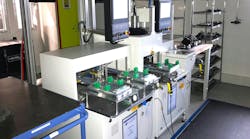By John Keller
VANCOUVER, Wash. — Diode lasers and the global positioning system (GPS) are among the chief technologies that are transforming the modern U.S. military, say officials of nLight Photonics Corp., a manufacturer of high-power diode lasers in Vancouver, Wash.
A diode laser, or "semiconductor laser," combines a semiconductor chip that does the actual lasing, and a monitor photodiode chip for feedback control of power output. These devices use tiny chips of gallium arsenide or other exotic semiconductors to generate coherent light in a small package, which is of great interest to fighting forces deployed in the field.
Special Operations forces, for example, use diode lasers to illuminate targets on the battlefield, and use GPS to navigate, says Scott Keeney, president and chief executive officer of nLight. "Ten to 20 years ago there was not a laser on the battlefield. Today they're everywhere."
Diode lasers, Keeney says, are far smaller and substantially more efficient than chemical lasers. Diode lasers, he says are 50 percent efficient, while chemical lasers are about 10 percent efficient.
Efficiency refers to the amount of light and waste heat a laser generates, relative to the amount of electrical power that goes into the device. A 100-watt laser that is 50-percent efficient would produce 50 watts of light and 50 watts of waste heat.
Efficiency, company officials say, is a driving trend in military optoelectronics technology development. "Efficiency is key to directed-energy applications," says Jason Farmer, nLight's vice president of advanced technology. "We want to build 100-kilowatt devices for solid-state lasers."
Increasing efficiency of lasers would translate into fewer batteries that fighting forces in the field would have to carry, Farmer says. "For the Special Ops guy on the ground, the heaviest thing he carries today is batteries — 15 to 25 pounds of them," Farmer says.
"If you go to 80 percent efficiency from 50 percent, you could reduce the power consumption by 75 percent, which is important for cooling and input power." He says 80-percent efficient lasers might cut battery weight in the field by half.
Toward this goal, nLight and two other optoelectronics companies are working with the U.S. Defense Advanced Research Projects Agency (DARPA) in Arlington, Va., on a three-year program called Super High Efficiency Diode Source, otherwise known as SHEDS, which began last September.
The goal of SHEDS is to achieve 80 percent electrical-to-optical efficiency in the generation of light from stacks of semiconductor diode laser bars, operating in the 880- to 980-nanometer spectral range, for pumping directly into the upper laser level of Nd and Yb:YAG lasers.
DARPA has awarded nLight a $5 million contract for the SHEDS program. Other companies involved in the SHEDS program are Alfalight Inc. in Madison, Wis., and JDS Uniphase Corp. in San Jose, Calif., Farmer says.


